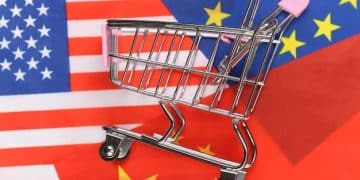Navigating Rising Inflation: Strategies for US Importers

Navigating the Impact of Rising Global Inflation: Strategies for US Importers to Mitigate Costs involves implementing measures such as diversifying sourcing, optimizing supply chains, hedging currency risks, and negotiating with suppliers to maintain profitability amidst increasing economic pressures.
The surge in global inflation presents significant challenges for US importers. Navigating the Impact of Rising Global Inflation: Strategies for US Importers to Mitigate Costs requires proactive measures to safeguard profitability and maintain a competitive edge.
Understanding the Global Inflationary Landscape
Global inflation, characterized by a sustained increase in the general price level of goods and services, has become a pressing concern for businesses worldwide. US importers, particularly, are feeling the squeeze as they grapple with higher costs across their supply chains. Understanding the root causes and impacts of this inflation is crucial for developing effective mitigation strategies.
Factors Fueling Global Inflation
Several factors contribute to the current inflationary environment. These include:
- Increased Demand: As economies recover from pandemic-induced slowdowns, pent-up demand puts upward pressure on prices.
- Supply Chain Disruptions: Ongoing disruptions in global supply chains, exacerbated by geopolitical tensions and logistical bottlenecks, lead to higher input costs.
- Energy Price Hikes: Rising energy prices, driven by geopolitical instability and increased demand, ripple through the economy, impacting transportation and production costs.
Impact on US Importers
For US importers, the impact of rising global inflation is multifaceted:
- Higher Procurement Costs: Increased prices for raw materials, components, and finished goods directly impact import costs.
- Increased Transportation Expenses: Elevated freight rates and fuel surcharges contribute to higher landed costs.
- Reduced Profit Margins: Importers face challenges in passing on increased costs to consumers, leading to diminished profit margins.
In summary, the inflationary landscape presents numerous challenges for US importers, making strategic cost management essential for survival and success.

Diversifying Sourcing for Cost Efficiency
Diversifying sourcing strategies is a powerful tool for US importers seeking to mitigate the impact of global inflation. By expanding their supplier base, importers can reduce dependence on any single source and leverage competition to negotiate better prices and terms.
Exploring Alternative Suppliers
Identifying and vetting alternative suppliers in different regions can offer significant cost advantages. Consider the following:
- Emerging Markets: Explore opportunities in emerging markets with lower labor costs and favorable exchange rates.
- Regional Suppliers: Focus on regional suppliers closer to the US to reduce transportation costs and lead times.
- Onshoring/Nearshoring: Evaluate the feasibility of onshoring or nearshoring production to gain greater control over costs and supply chains.
Building Strong Supplier Relationships
Cultivating strong relationships with multiple suppliers is essential for long-term success. This involves:
- Regular Communication: Maintain open and transparent communication with suppliers to stay informed about market conditions and potential cost changes.
- Collaborative Negotiation: Engage in collaborative negotiation to find mutually beneficial solutions that address cost pressures.
- Long-Term Contracts: Consider long-term contracts with key suppliers to secure favorable pricing and supply commitments.
In conclusion, diversifying sourcing and building strong supplier relationships offers a resilient and cost-effective approach for US importers facing inflationary pressures.
Optimizing Supply Chain Management
An optimized supply chain is crucial for minimizing costs and improving efficiency in the face of rising global inflation. US importers can leverage various strategies to streamline their operations and reduce vulnerabilities.
Inventory Management Techniques
Efficient inventory management is essential for minimizing holding costs and mitigating the risk of obsolescence. Consider the following:
- Just-in-Time (JIT) Inventory: Implement JIT inventory management to minimize stock levels and reduce storage costs.
- Demand Forecasting: Utilize advanced demand forecasting techniques to optimize inventory levels and avoid stockouts or overstocking.
- ABC Analysis: Prioritize inventory management efforts based on the value and demand of different products.
Transportation and Logistics Optimization
Optimizing transportation and logistics can significantly reduce shipping costs and improve delivery times. Explore the following strategies:
- Consolidation: Consolidate shipments to reduce freight costs and improve efficiency.
- Route Optimization: Utilize route optimization software to identify the most efficient and cost-effective transportation routes.
- Negotiate Freight Rates: Negotiate favorable freight rates with carriers and explore alternative transportation modes.
By optimizing supply chain management, US importers can reduce costs, improve efficiency, and build resilience against inflationary pressures.
| Key Point | Brief Description |
|---|---|
| 🌍 Diversify Sourcing | Explore new suppliers and regions to reduce reliance on single sources. |
| 📦 Optimize Supply Chain | Improve efficiency in inventory, transportation, and logistics. |
| 💱 Hedge Currency Risks | Use financial instruments to protect against exchange rate fluctuations. |
| 🤝 Negotiate with Suppliers | Collaborate to find mutually beneficial solutions amid rising costs. |
Frequently Asked Questions
▼
Global inflation is primarily driven by increased demand, supply chain disruptions, and rising energy prices. These factors combine to push up the general price level of goods and services worldwide.
▼
Inflation increases procurement and transportation costs for US importers, reducing their profit margins. Passing these costs to consumers can be difficult, further squeezing profitability.
▼
Diversifying sourcing reduces reliance on single suppliers, allowing importers to negotiate better prices and terms. Exploring alternative suppliers in different regions can also offer cost advantages.
▼
Key inventory management techniques include Just-in-Time (JIT), demand forecasting, and ABC analysis. These methods help minimize holding costs and prevent stockouts or overstocking effectively.
▼
Importers can use financial instruments such as forward contracts, currency options, and currency swaps. These tools provide protection against adverse exchange rate movements.
Conclusion
In conclusion, Navigating the Impact of Rising Global Inflation: Strategies for US Importers to Mitigate Costs requires a multifaceted approach. By diversifying sourcing, optimizing supply chains, hedging currency risks, and fostering strong supplier relationships, US importers can effectively weather the inflationary storm and position themselves for long-term success in the global marketplace.





